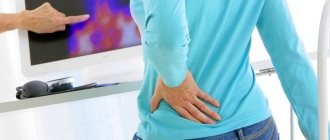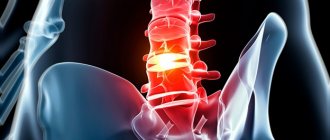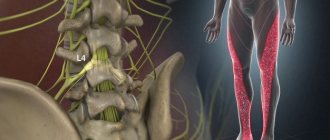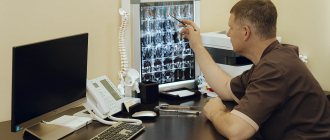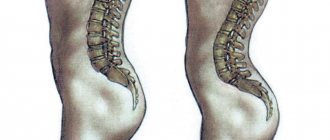According to the International Classification of Diseases (ICD-10), spinal spondylosis is assigned the code M47. It is classified as a disease of the musculoskeletal system and connective tissue. This name hides chronic degenerative-dystrophic processes in the spinal column. Their characteristic feature is the appearance of osteophytes - growths of bone tissue along the edges of the vertebral segments. They are what cause spinal deformation. It is most often diagnosed in people over 50 years of age, but it begins to develop much earlier.
What is spondylosis?
Due to the presence of pointed growths, the spinal canal and intervertebral foramina narrow. As the pathology develops, osteophytes grow to impressive sizes, blocking the mobility of the vertebrae and squeezing the nerve roots.
At the initial stage, spondylosis is a compensatory reaction of the body, which thus tries to reduce excessive load on the spine. At this stage there are no clear clinical manifestations yet, but a feeling of stiffness already appears.
Gradually, the process becomes pathological and can lead to fusion of the vertebrae. This causes severe pain, significant stiffness and a feeling of heaviness in the affected area. The functioning of blood vessels, nerves, muscle tissue, and adjacent organs is disrupted, back muscles atrophy, and intervertebral hernias form.
Spondylosis can affect any part of the spine and is more common in women. In men, it is diagnosed three times less often. The effectiveness of treatment depends on the stage at the time of detection, general condition, concomitant diseases and compliance with medical recommendations. If therapy is started in a timely manner, there is no need for surgery. Otherwise, critical changes develop, as a result of which a person loses his ability to work and becomes disabled.
Description of the disease
Doctors use this term to describe a disease that leads to the destruction of bones and cartilage in the cervical spine. Because of it, the nerve endings suffer, the lumen of the spinal canal narrows - this phenomenon causes pinching of the spinal cord, and the vertebrae themselves are not able to function normally.
Over time, a person begins to experience pain and discomfort, and growing osteophytes injure adjacent tissues. At risk are people who are forced to spend the entire day in front of a monitor. Few people monitor and maintain their posture - the back, as a rule, is rounded, and the head “goes” forward as the person peers at the image on the screen. As a result, the disease has become significantly “younger” compared to the previous generation.
Causes of spondylosis
Overgrowth of vertebrae with osteophytes can be caused by the following reasons.
- Age-related changes that lead to disruption of metabolic processes, a decrease in the concentration of calcium, phosphorus, sodium, magnesium, collagen.
- Overweight. The skeletal system is designed to bear a certain load, and it is different for each person. Its regular excess gives rise to degenerative-dystrophic processes.
- Unbalanced diet. The body does not receive the required amounts of vitamins, micro- and macroelements necessary for bone tissue through food.
- Physical inactivity. The cause of spondylosis is not only sedentary work, but also long-term limitation of physical activity due to any disease.
- Rare increased physical activity with a sedentary lifestyle (for example, weekly work in a summer cottage).
- Constant excessive loads. They lead to disruption of the smooth functioning of the spine. This factor is the main cause of spondylosis in men aged 40 years and older.
- Spinal injuries, systematic microtraumas of the spine.
- Systemic connective tissue diseases: rheumatoid arthritis, lupus erythematosus, scleroderma.
- Other diseases of the spine: osteochondrosis, spondylolisthesis.
- Congenital anomalies, genetically determined pathology of cartilage tissue.
- Acquired or congenital deformation of the spinal column: kyphosis, scoliosis.
- Disorders of metabolic processes, including endocrine pathologies.
Treatment of spondylosis is carried out comprehensively and is aimed not only at relieving symptoms, but also eliminating the causes.
Epidemiology
Cervical spondylogenic myelopathy is the most common cause of non-traumatic spastic paraparesis and quadriparesis. Almost 23.6% of patients with non-traumatic myelopathic symptoms had cervical spondylogenic myelopathy.
Cervical spondylosis is more common in men.
The results of studies using radiographic data showed that spondylous changes are most common in people over 40 years of age. After all, more than 70% of men and women suffer from spondylosis in adulthood, but radiographic changes are more pronounced in men than in women.
Obvious symptoms of spondylosis
These include pain, limited mobility, and stiffness. These manifestations vary in nature and intensity depending on the location of the pathological processes. For example, pain in spondylosis can be sharp, aching, wave-like, permanent (pulsating) in nature.
Cervical region
Spondylosis of the cervical spine is the most common. Many professions require an uncomfortable neck position throughout the working day. Office workers, freelancers, programmers, accountants virtually sit at their desks all day. The cervical region is the most mobile, does not experience heavy loads, and is distinguished by small, vulnerable vertebrae. Causes of cervical spondylosis also include flat feet and uncomfortable postures during sleep.
Manifestations:
- when you turn your head, your neck cracks;
- movement is limited;
- the back of the head regularly ache;
- headache;
- shoulder joints ache;
- sleep is disturbed.
The pain syndrome manifests itself more clearly during the daytime. It does not disappear during rest, but becomes less pronounced. The patient cannot fall asleep for a long time due to the inability to find a comfortable position, and wakes up regularly.
Consequences:
- Unstable blood pressure;
- Hearing impairment;
- Decreased visual acuity;
- Systematic dizziness;
- Constant weakness and drowsiness;
- Deterioration of memory and concentration.
In advanced cases, compression of the nerve occurs, the upper limbs become numb, and the development of muscle weakness and paralysis is possible.
Thoracic region
The thoracic vertebrae are rarely affected, and the symptoms of spondylosis are distinct. Characterized by constant pain in the middle and lower thoracic spine, which intensifies with movement: bending to the side, flexion-extension of the body. During painful attacks, breathing may be impaired and shortness of breath may occur. Most often, unilateral spondylosis extends to the chest area.
Manifestations:
- disruptions in the gastrointestinal tract;
- sometimes dyskinesia;
- stiffness upon awakening;
- heaviness and pain in the chest area.
Lumbar
The lower back loses mobility - it is difficult to stay in one position for a long time.
Manifestations:
- constant debilitating pain in the lumbar region;
- lumbago in the form of single intense impulses;
- complete or partial loss of sensitivity during exercise;
- unpleasant, aching sensations in the thighs and buttocks;
- cotton or wooden legs syndrome;
- intermittent claudication.
With lumbar spondylosis, pain increases significantly when going down stairs, being in an unnatural position, or bending the body. The condition improves significantly in a supine position on the stomach.
When the vertebrae are displaced towards the abdominal or thoracic cavity (antespondylolisthesis), cauda equina syndrome may develop. It is accompanied by excessive pressure and swelling of the nerve endings in the lower spinal cord. In addition to the above symptoms, the patient experiences neurological manifestations:
- pronounced pain, burning, tingling, complete or partial loss of sensation in the lower back, buttocks and thighs;
- muscle weakness in the legs;
- impaired coordination of movements;
- loss of bowel and bladder control;
- erectile disfunction.
The condition is characterized by rapid development during the day and requires emergency medical care. Surgical decompression reduces or eliminates pressure on the affected nerves.
Risk factors
The biggest risk factor for developing cervical spondylosis is aging. Cervical spondylosis is usually associated with involutional changes in the joints of the neck. Disc herniation, degeneration and bone growths (osteophytes) are all associated with involutional changes in the body.
Other risk factors:
- neck injuries
- heavy lifting work that places additional strain on the neck
- holding the neck in an awkward position for a long time or repeating the same neck movements throughout the day
- genetic determination
- smoking
- overweight and inactivity
Stages of development of spondylosis
The development of spinal spondylosis occurs in several stages.
I. At first, there are practically no symptoms of spondylosis. The size of single spine-shaped osteophytes is not large and does not cause discomfort. Fibrous tissues lose elasticity and undergo initial changes: cracks and breaks. Symptoms are inherent only to lumbosacral spondylosis in the form of periodic, minor lumbar pain, which, as a rule, goes unnoticed. At this stage, osteophytes are located within the boundaries of the vertebrae, which makes early diagnosis difficult. The first stage is considered dangerous and unpredictable, as it goes unnoticed by the patient and doctors.
II. Osteophytes continue to actively grow. Symptoms of spondylosis are manifested by limitation of movements, aching pain, which intensifies with physical exertion and even slight hypothermia of the body.
III. At the third stage, pathological processes acquire a pronounced form. Even incorrigible optimists who tried to cope with spinal spondylosis on their own or ignored its symptoms turn to doctors. There is a significant proliferation of bone formations with the appearance of coarse osteophyte complexes. They connect the vertebrae and completely destroy the cartilage tissue. The person feels severe pain, loses ability to work, and complete immobility and disability are possible.
When should you see a doctor?
If a person suddenly experiences numbness or tingling in the shoulder, arms or legs, or if the person has lost bowel or bladder control, then seek medical help as soon as possible!
If discomfort and pain begin to interfere with daily activities, it is necessary to consult a neurologist. Despite the fact that spondylosis is part of involutional changes, there are nevertheless various treatment methods that can improve well-being and reduce symptoms.
How to detect spondylosis?
If you suspect spinal spondylosis, you should consult a vertebrologist or orthopedist; it is possible that you will need the help of a neurologist. The specialist assesses the general condition of the patient, listens to his complaints, collects anamnesis, and performs palpation to identify lesions.
The clinical manifestations of spondylosis are in many ways similar to other diseases of the musculoskeletal system. This necessitates a comprehensive examination and the appointment of the following studies.
- X-rays
– for visualization of osteophytes. On an x-ray they appear as asymmetrical, fringed formations of irregular shape. It clearly shows the condition of the joints and the distance between the vertebrae.
- Magnetic resonance imaging (MRI)
— to assess the condition of nerves, ligaments, discs. It identifies the location of nerve compression, which allows you to accurately determine the cause of pain.
- Computed tomography (CT)
– for detailed visualization of the spine. Based on its results, stenosis is identified, accompanied by a narrowing of the spinal canal or intervertebral foramina.
The need for electroneuromyography (ENMG) arises when nerve damage is suspected. During this study, nerve impulses are recorded and analyzed.
Additional diagnostics are carried out at the discretion of the doctor. He may prescribe Dopplerography of cerebral vessels, electrocardiogram, and laboratory blood tests.
Physical examination
First, the doctor finds out the presence of symptoms, their intensity, location, and history of the disease. A neurological examination is then performed, which includes examining reflexes, testing muscle strength, and determining sensory deficits and range of motion in the neck. A doctor may perform a gait analysis to determine how much damage to the spinal cord is present.
If a doctor suspects cervical spondylosis, he will order imaging tests and neurophysiological studies to verify the diagnosis.
How is spondylosis treated?
The treatment regimen is determined by the doctor based on diagnostic data. Therapy methods are selected taking into account the individual characteristics of the patient, concomitant diseases, the nature and stage of pathological processes.
Spinal spondylosis is chronic, accompanied by irreversible degenerative processes and cannot be completely cured. Therapeutic measures are aimed at eliminating the causes of the pathology, reducing clinical manifestations and preventing further development of dystrophic changes. It is also important to strengthen the muscles and ligaments of the spine and improve blood circulation.
Drug therapy
When treating spondylosis, several groups of drugs are prescribed.
- Analgesics and non-steroidal anti-inflammatory drugs
, relieving pain. In severe cases, novocaine blockade and narcotic drugs help.
- Antidepressants
. Their action is aimed at reducing chronic pain syndrome and the depressive state caused by it.
- Chondroprotectors,
restoring cartilage and bone tissue. The most recommended is Artradol, which triggers the renewal mechanism of damaged tissues of joints, cartilage, and bones.
- Vitamin complexes.
As maintenance therapy, vitamins of groups A, C and D are especially expensive.
- Hyaluronic acid injections.
It improves cell nutrition and prevents further development of pathology.
An effective addition to the complex treatment of spondylosis are external ointments and gels with analgesic and anti-inflammatory effects. Together with Artradol, they significantly speed up recovery.
The effectiveness of physical therapy and massage
Exercise therapy in the treatment of spondylosis is necessary for:
- strengthening the muscle frame, which prevents displacement of the vertebrae and the appearance of intervertebral hernia;
- eliminating spasms;
- activation of blood flow;
- preventing the development of osteophytes;
- preparing the patient for everyday stress.
Special exercises for the treatment of spondylosis are selected by the attending physician on an individual basis and are initially performed under the supervision of a trainer.
Massage sessions will help get rid of spasms and pain, strengthen muscles, prevent compression of nerves, and activate blood flow.
Other methods
- Shock wave therapy in the treatment of spondylosis activates lymph and blood flow, stabilizes muscle tone, and destroys bone growths. The method is effective in the initial stages of the disease.
- Laser therapy significantly improves microcirculation, reduces muscle tension, and reduces pain.
- Acupuncture is used to reduce pain and improve the conduction of nerve impulses.
- The effect of electrical stimulation and cryotherapy is to reduce pain and slow down the development of pathological processes.
Surgery
Surgery for the treatment of spondylosis is performed as a last resort, when, despite all the methods and means used, conservative therapy has not led to the desired result. After it, severe neurological symptoms are present for a long time, and spinal stenosis or intervertebral hernia often develops.
Visualization methods
- X-rays can be used to visualize bone spurs and other abnormalities.
- A CT scan can provide more detailed images of the neck.
- MRI scans, which create images using radio waves and a magnetic field, help doctors detect compression of nerve structures.
- Myelogram - This procedure uses contrast to be injected into specific areas of the spine. A CT scan or x-ray is then used to take more detailed images of these areas.
- EMG (ENMG) is used to test the functionality of nerve fibers, the method checks the electrical activity of the nerves and the conduction of impulses to the muscles.
- ENMG determines the speed and strength of the signals that the nerve sends. This allows you to determine the presence and level of damage to nerve fibers.
Prevention
Treatment of cervical spondylosis is a long and complex process . It is easier to prevent a disease than to figure out in the future how to normalize the condition.
Basic methods of prevention:
- use of orthopedic mattresses for sleep and rest;
- yoga classes;
- swimming;
- maintaining correct posture.
It is important to walk more, while keeping your back and head straight. People working at a computer should warm up their neck and shoulders at least once every 1-2 hours: make circular movements with their shoulders, tilt their heads in different directions.
Surgery
Surgery is not usually used for cervical spondylosis unless the condition is specific. For example, when the spinal cord and nerves are under pressure and the patient has progressive neurological symptoms such as arm weakness and anesthesia.
Surgery may also be recommended if you have severe pain that does not improve with non-surgical treatments. However, some patients with severe neck pain will not be candidates for surgery, which may be due to the advanced nature of their osteoarthritis, other medical problems, or other causes of their pain, such as fibromyalgia.
Why do osteophytes appear?
If the muscles and ligaments are weakened, then the neighboring vertebrae become unstable and begin to “play” - shift relative to each other. The receptors are constantly irritated, causing pain. To avoid this discomfort, the body tries to cope with the problem on its own by fixing the spine, increasing the contact area of the vertebrae by building up bone tissue and compressing muscles. Thus, the course of the disease provides the key to the solution - improving the condition of the muscles is very important in order to avoid the formation of osteophytes.
Possible complications
In the absence of timely treatment, thoracic spondylosis can cause respiratory dysfunction and compression of internal organs. In addition, other complications are also dangerous:
- Unbearable pain that can only be relieved by epidural blockades.
- Formation of protrusions and intervertebral hernias.
- Impaired motor activity, paralysis.
- Urinary incontinence or spontaneous bowel movements.
- Spinal stenosis.
- Sexual dysfunction.
The degenerative processes that spondylosis provokes are irreversible, so treatment can be started as early as possible. Conservative treatment, physiotherapy and exercise therapy can only temporarily slow down the process and ensure stable remission.




